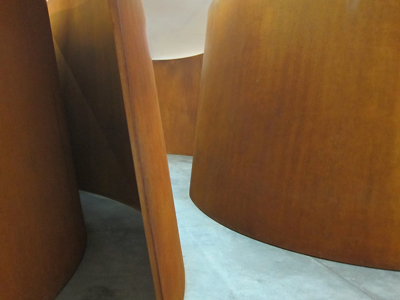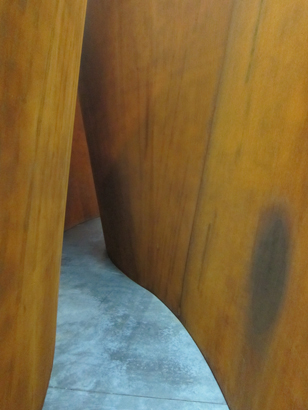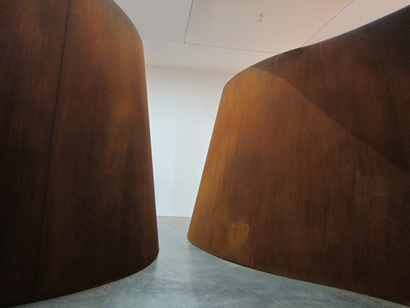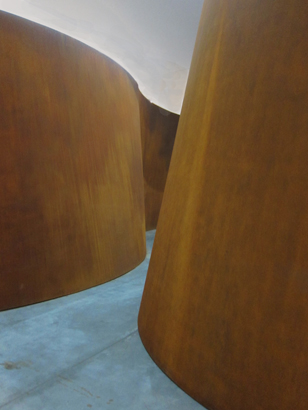Walking the Serra Torque
patrick brennan
December 2013
It really fascinates me that Richard Serra’s “rusted metal wall” was publicly flogged out of Federal Plaza for how it disturbed people because this same artist’s work, for me, feels so amazingly sympathetic, even simpático. The sculptures seem to exude out of a powerfully committed trust in sensory experience that’s shaped within a wily respect for its practical limits.
The extravagance of these massive steel constructions leave it pretty obvious that they couldn’t possibly happen at all without Big Money and, with that, a commercial infrastructure extending from the excessively funded to dealers to museums to universities. It’s work that’s neither cheap nor easy to make, but neither is it especially fawning toward individual property owners.
 Torqued steel sculptures like Inside Out (at Gagosian in Chelsea through February 8th) tug curiosity. Their looping sinuosity can easily intrigue and inform from a distance, but mystery really steps up at close range, where their scale makes its most precise and tactile sense. High edges loom the periphery without blurring or falling out of sight, posing an interference that continually alerts and widens focus. The span of one’s own visual field defines the measure of the work’s frame.
Torqued steel sculptures like Inside Out (at Gagosian in Chelsea through February 8th) tug curiosity. Their looping sinuosity can easily intrigue and inform from a distance, but mystery really steps up at close range, where their scale makes its most precise and tactile sense. High edges loom the periphery without blurring or falling out of sight, posing an interference that continually alerts and widens focus. The span of one’s own visual field defines the measure of the work’s frame.
Deadpan, these constructions cleverly play a viewer with lures of surface breaks, outlets and entrances to some yet unseen that can only be witnessed by walking in, through, around, inside. One’s own physical movement turns more than adjunct to observation in order to act out these performative components of the sculpture.
 The metal’s oxidated edges bark sharp relief to the whiteness of ceiling or grayness of floor, each graphically stamping out evocations of 2 dimensional shapes that modulate step by step as do consecutive film frames, each still vista an intact entity of its own amid a rotunda of plausible paintings. For a viewer in motion, the margins of these shapes seem to draw themselves, entangling attention in indeterminate swells of potential alternatives – as if one were doing the drawing oneself.
The metal’s oxidated edges bark sharp relief to the whiteness of ceiling or grayness of floor, each graphically stamping out evocations of 2 dimensional shapes that modulate step by step as do consecutive film frames, each still vista an intact entity of its own amid a rotunda of plausible paintings. For a viewer in motion, the margins of these shapes seem to draw themselves, entangling attention in indeterminate swells of potential alternatives – as if one were doing the drawing oneself.
At first approach, the enormity of these constructs could, for some, smack of hubris, gratuitous ego or even of a flexing of the privileges of power; but these rhetorical impressions sidestep just how aptly well tailored the sculptures bend toward human view. The active proportions of the body feel incorporated into their organization. It’s not just how vision’s roundish horizon gets so consistently well stoked, it’s how overhead views so perfectly accommodate full rotations of the neck or how the pacing of corridors and interior plazas syncopate a stroll.
The walls’ undulations seem to recognize specific quirks of how a body perceives, demonstrating a respect that might earn some reciprocal consideration, and even a degree of trust and participation, from a viewer. The shaped volumes of these interiors reach under the skin into proprioceptive assessments of location, amplitude, pressure, anticipation and a spectrum of other sensations that are a lot easier to recognize than name. Shifts in one’s own sense of equilibrium might even find a person inclined at times to walk as bent as the sculpture itself.
 There’s an elegance and simplicity to how all of this is accomplished. The sculptures seem almost self evident and self explanatory – at least in the sense that they don’t pine for an instruction manual or lean on volumes of literary disclaimers, as does so much Conceptual Art; nor are they remote or reductive, as has been a common recourse of Minimalism. They’re not Platonically abstract in this regard, but specifically corporeal and, already, ever so gradually decaying.
There’s an elegance and simplicity to how all of this is accomplished. The sculptures seem almost self evident and self explanatory – at least in the sense that they don’t pine for an instruction manual or lean on volumes of literary disclaimers, as does so much Conceptual Art; nor are they remote or reductive, as has been a common recourse of Minimalism. They’re not Platonically abstract in this regard, but specifically corporeal and, already, ever so gradually decaying.
These “rusted metal walls” are remarkably unprepossessing for what they may seem to address. They may just sit there without a word like old fashioned “art objects,” yet they potentially attract so much of what’s been dear and distinctive to alternative strategies of contemporary art. The artist/audience barrier is breached as a viewer has to assume the agency of performer simply in order to see the work, which opens to some of the democratizing intents of the Happening, to a commonality with Performance Art, and somewhat less visibly and demonstratively with Body Art. All of this without explicitly telling anyone what to do.
 In this respect, a torque sculpture functions as a topographical score that leaves a lot of interpretive detail to performers. Serra’s thorough and astute mappings of shaped motion further parallels the architectural sensibilities of sound artists such as Xenakis, Monk, Varèse, Cecil Taylor or Elvin Jones.
In this respect, a torque sculpture functions as a topographical score that leaves a lot of interpretive detail to performers. Serra’s thorough and astute mappings of shaped motion further parallels the architectural sensibilities of sound artists such as Xenakis, Monk, Varèse, Cecil Taylor or Elvin Jones.
Walking a Serra torque shapes so much like a cave or a narrow canyon. It can withstand behaving like a carnival funhouse. It landscapes in a way that calls on our long, far more than human, animal history as terrestrial navigators, with all the broad intelligence and feeling that involves. Yet, its depth of internal coordination carries beyond entertainment, and the work is decidedly art-ificial. Each nuance is carefully and deliberately crafted and tuned to the natural biases and distortions of human perception.
Serra designs an experiential homeostasis, a living convergence between unintegrated extremes, that no matter how many times one may repeat a path through a torque, it’s never the same. The complexity of relationships within the work stay accessible enough to keep one’s wonder poised on the lively edge of the recognized and the uncomprehended.
